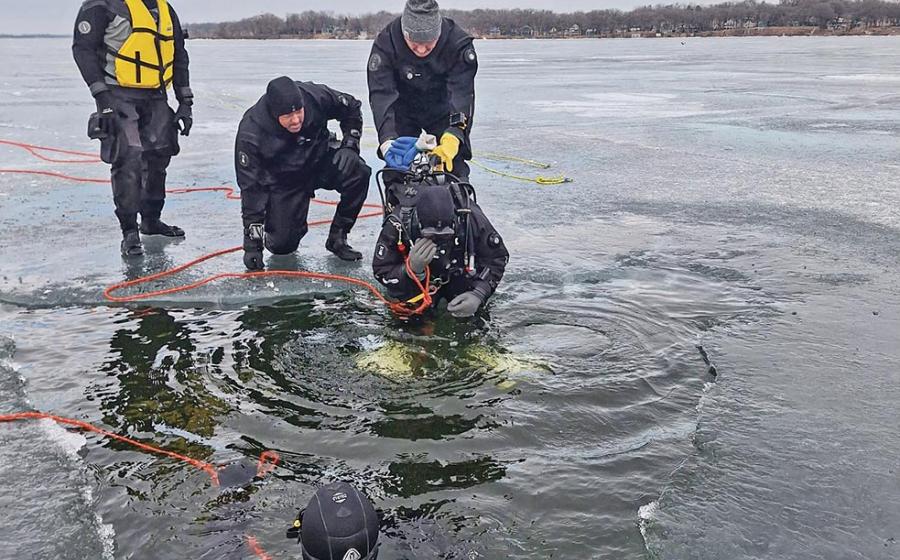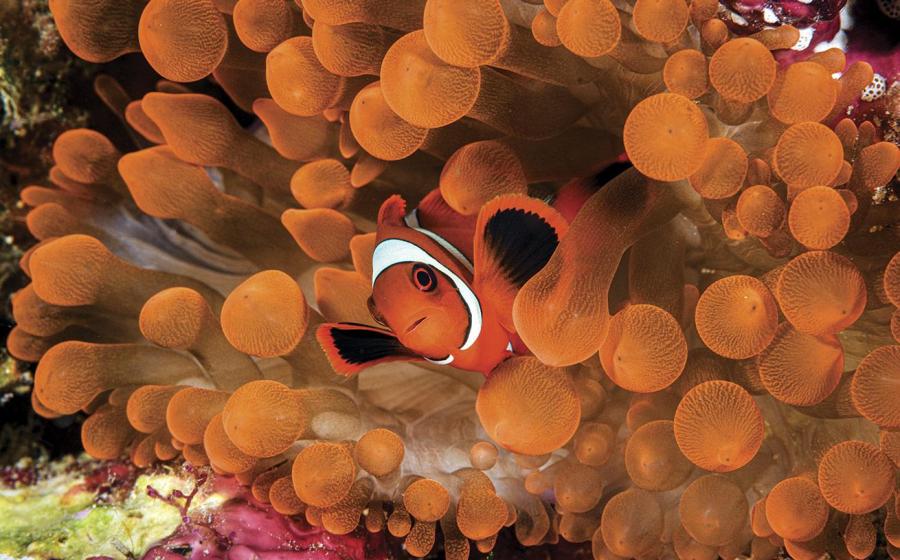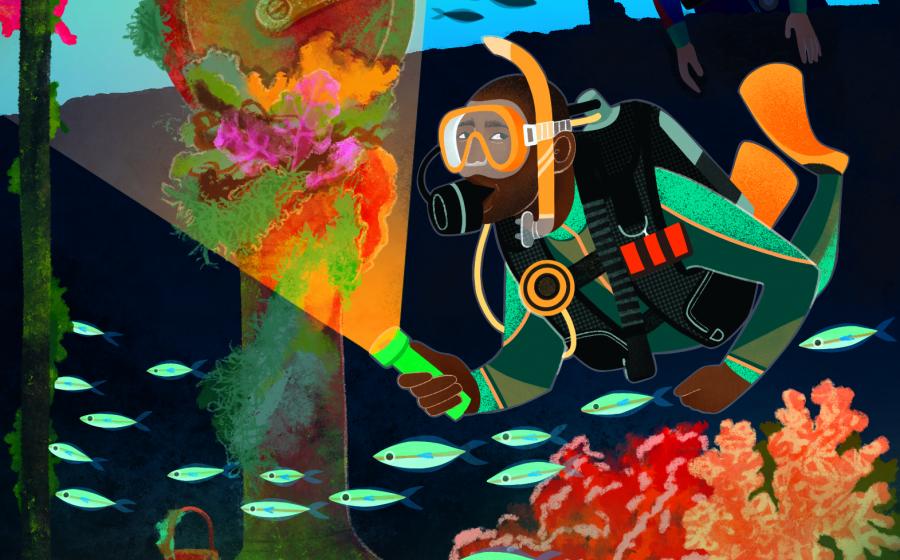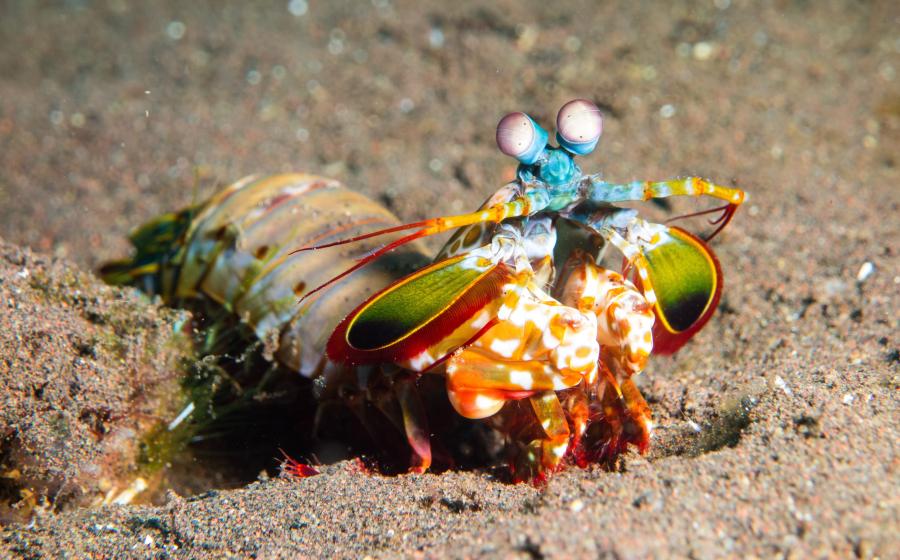Guinness Book Dive: Nakwakto Rapids, BC
The Guinness Book of World Records lists the Nakwakto Rapids of British Columbia, Canada as having the strongest currents in the world. Turret Rock sits smack in the middle of the ominous Nakwakto Rapids and was my next dive site. Scared? A wee bit.My dive buddies and I hiked up through an old-growth forest to get a birds-eye view of Turret Rock. The stubborn stone stood defiant against the churning currents. The Nakwakto Rapids are caused by an enormous amount of seawater squeezing through a sliver of a channel during tidal exchanges. The surrounding Seymour Inlet area consists of glacier-carved waterways with 950 miles of shoreline. When all of this water makes its way to and from the Pacific Ocean, the Nakwakto Rapids can rip around Turret Rock at 16 knots.Tacked up on the cedar trees crammed on the tiny rock were wood placards with scrawled names. They looked like grave markers.''What's with the signs?'' I asked.''It's a macho thing to put your name on Turret Rock,'' said Bud Bowles, owner of the Seymour Inlet Lodge. Bud has lived in this wilderness for 22 years on his self-built floating home. He knows the waters of Seymour Inlet like the zipper of his dry suit, and has taken scores of divers to the infamous Turret Rock. At 60, he seemed to view the signs as youthful territory markings.''So you don't have a sign on Turret Rock?'' I said.''Mine is one of the highest up there, eh?'' he grinned. Bud has a dry wit so subtle it's hard to know when he's serious or joking. I found all of the Canadian divers in my group to possess this relaxed, half-whacked demeanor. But it went beyond jokes and carried over into diving. None of them seemed to share the insurmountable fear I had of diving Turret Rock.For the dive briefing, Bud's son, Chris, had drawn a battle plan on the board. Diving Turret Rock is easy he said -- if you follow the plan. The Canadians asked no questions. I, on the other hand, rattled off a barrage of inquiries and ''what ifs.'' Chris answered my panicked pleas, but made it clear there was no room for error. I studied Chris, a 27-year-old with a shaved head, goatee, and fish hooks piercing his ears, searching for a hint of humor in his eyes. But this was no joke. We were about to dive the strongest currents in the world. I made a nervous pit stop before donning my dry suit as I wanted it to stay that way.Motoring to the site, the Canadians treated this as just another dive. Brian was a jovial diving instructor partial to dives in ice-covered lakes. Sarah and Geoff wore wet suits in 460F water and had less than 10 dives under their heavily-leaded weight belts. Albert joked about never getting his diver's certification. Norm used duct tape to patch leaks in his dry suit. And then there was Bud, driving the skiff. Isolated in the wilderness for 22 years would have to take a toll on one's judgment, eh? And I, the naive Yankee, was entrusting my life to these loony Canucks.But it was too late. We were at Turret Rock. The twisted trees and foreboding signs loomed large, like an exaggerated graveyard scene in a horror flick. All week, I'd seen the Nakwakto Rapids rushing past the rock, but now at slack tide the water was dead calm, downright eerie on this gray misty day.''You've got 15 minutes to get to the back of Turret Rock before the current starts,'' said Bud. ''See you at the end of the dive.''I raced into my tank and rolled off the skiff. Time's a wastin' when you've got record speed currents on your tail. I jet-finned to the highlight of the dive -- a huge mass of gooseneck barnacles (related to Pollicipes polymerus). These brilliant red and mother-of-pearl crustaceans require highly oxygenated water and thrive in the strong currents of the Nakwakto Rapids. Typically found in intertidal surf zones too treacherous for divers, the goosenecks are Turret Rock's other claim to fame. Checking my watch, I continued, staying ahead of the current. White plumose anemones blanketed the rocky wall, like snow on a hillside. Scalyhead sculpins studied me with their bulging eyeballs. Decorator crabs plastered with sponges scurried into crevices. Following the plan to the exact minute, I reached the back side of Turret Rock where the rest of the divers hovered in a kelp bed. Poking their heads up among the green fronds, they looked like neoprene-clad gophers.We surfaced in a protected back eddy, and not a stone's throw away foamed a torrid wall of water created by the Nakwakto Rapids. True to his word, Bud was there to pick us up.''Looks like you survived,'' he grinned. I grinned back. But the fun had just begun. The Nakwakto Rapids were now running at about a 5-knot current and increasing fast. Bud spun the skiff around and dropped us in the water for a wild ride.Shooting through the rapids in our pumped up dry suits, we looked like human beach balls bobbing and spinning on the surface. We belly flopped back into the boat and zipped over to the ''Toilet,'' a 10-foot wide cut between two land bodies near Turret Rock. Within minutes of dropping into the water, the force of the current flushed us out the other side. Motoring back to the lodge, we passed Turret Rock and the still turbulent Nakwakto Rapids. Putting a sign on the famous rock now made sense. It was better than an ''I Survived Turret Rock'' t-shirt. ''Hey Bud, how high is your sign on Turret Rock?'' I asked.''Higher than you'll ever get yours up there, eh?'' he smiled.Crazy Canuck.RESOURCESGETTING THERE: The Seymour Inlet area is 120 miles north of the city of Vancouver on the mainland of British Columbia, and 7 miles east of Port Hardy on Vancouver Island. From Port Hardy, it's a 20-minute float plane ride to the Seymour Inlet Lodge, the only lodging near the Nakwakto Rapids. Live-aboard dive boats also take divers to the Nakwakto Rapids site. Pacific Coastal Airlines flies 55-minute flights from Vancouver to Port Hardy. BC Ferries runs several ferries a day from Vancouver to Vancouver Island.Pacific Coastal AirlinesPhone: (800) 663-2872Web site: www.pacific-coastal.comBC FerriesPhone: (250) 386-3431Web site: www.bcferries.bc.ca/WHERE TO STAY:Seymour Inlet LodgeP.O. Box 1229Port Hardy, B.C. V0N 2P0Phone: (888) 978-9050Fax: (604) 438-4444Web site: www.scubabc.comDIVING:Seymour Inlet Lodge (see above)Clavella AdventuresP.O. Box 866Nanaimo, B.C. V9R 5N2Phone: (250) 753-3751Fax: (250) 755-4014Web site: http://clavella.com/Nautilus ExplorerPhone: (888) 434-8322E-mail: [email protected] site: www.nautilusexplorer.comMamro Adventures1956 Zorkin RoadNanaimo, B.C. V9S 5T9Phone: (250) 756-8872Web site: www.extasea.comSea Venturer Sea Experience1956 Zorkin RoadNanaimo, B.C. V9S 5T9Phone: (250) 756-8895Web site: www.extasea.comWATER TEMPERATURES:Water temperatures average 490F. A dry suit or quarter-inch wet suit is recommended.BEST TIMES TO GO:June through OctoberMORE INFORMATION:Tourism British ColumbiaP.O. Box 9830Stn. Prov. Gov.Victoria, B.C. V8W 9W5Phone: (800) 435-5622Web site: www.hellobc.com






